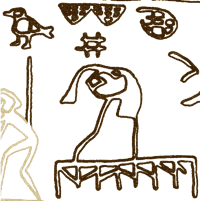
Queen Penebui on a label found in the tomb of Hemaka in Saqqara.
The title “Great of Sceptre” written before her name, Penebui is believed to have been a queen who lived during the 1st Dynasty. She is mentioned on several year labels dated to the reign of Horus Djer, making it likely that she was one of his wives.
A carving of Penebui on a label found in the tomb of Hemaka in Saqqara, has led some researchers to believe that the queen’s death was depicted.
The label shows the queen, identified by her title “Great of Sceptre” and her name, seated on some sort of pedestal. Her body is wrapped in a cloth, hiding all of her limbs. The explanation of the curved line protruding from the front of her head as a stream of blood, somewhat reminiscent of the way a fallen enemy was portrayed, resulted in the interpretation that the queen was portrayed as deceased.
Behind Penebui, a second queen, identified by the title “She who has seen Horus” but whose name is sadly lost, is shown in the same way, which would imply that she too had passed away.
The claim the 4th year of the reign of Djer on the Palermo fragment of the Annals Stone, records not only the death but the beheading of Penebui is too far-fetched. The signs in this year-cell are very difficult to understand and even though they may point to a sacrifice, there is no reference at all to the queen’s name.
Alternatively, it is possible that the sign protruding from Penebui’s and her colleague’s heads is not a stream of blood at all, but a lock of hair as an indication that they were in mourning. In that case, it is not the queens’ simultaneous deaths that is shown on the label, but the death of someone they both would mourn. The king himself, perhaps? Or a mutual relative?
Neither the names of her parents nor of any children she may have had, are known.